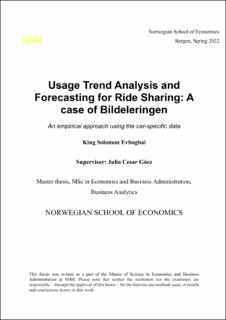Usage Trend Analysis and Forecasting for Ride Sharing: A case of Bildeleringen : An empirical approach using the car-specific data
Master thesis
Permanent lenke
https://hdl.handle.net/11250/3021325Utgivelsesdato
2022Metadata
Vis full innførselSamlinger
- Master Thesis [4372]
Sammendrag
Car-sharing is gaining a lot of popularity amongst users, as more people are finding various
instances and benefits to use this service. With this development, there is increasing number
of companies setting up car-sharing platforms to satisfy this growing demand. As is
characteristic of highly competitive industries, the players win market share by effective
planning and efficient operations. One aspect of effective planning is ensuring that the carsharing
fleet of cars is suitable to the needs of the target customers. The goal of this paper is
to use past data to analyse the car features that are affecting the demand of cars and propose a
model to predict the future demand of cars using these features.
To achieve this, we obtained the ride data from Bildeleringen, the leading car sharing operator
in Bergen (Norway). We analysed all of the data tables and picked the variables that were
essential to our study. After cleaning up the data, we created a new dataset that gave car level
information on the car type, car features, the availability period, and the usage variable.
We obtained two measures of usage from the data – time driven and kilometres driven. Based
on the business model of Bildeleringen where more of the cost of usage is attributed to the
driven time, we chose the time driven as the more appropriate usage measure. Also, we noticed
that some cars were available on the platform for way longer than others, hence we went a
step further to define the measure of usage as the kilometre driven as a ratio of the time
available on the platform.
Using charts, histograms, and box plots, we investigated the possible relation in the car
features and the usage of these cars on first glance. We then proceeded to run a multiple linear
regression on our data set. We then used 10 data prediction methods to model the car usage
and tested the predictive performance of the models using cross validation. The models used
belonged to the Linear regression, Ensembles, Decision tree, Bagging and Boosting.
The results of the show that are the car level features that affect the demand are transmission
type, wheel drive system, baby pillow availability, child seat installed, and roof box installed.
Based on the Mean Squared Error comparison, we also found that the Decision tree is the best
model to use for the prediction.
